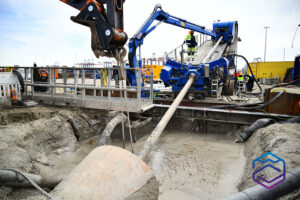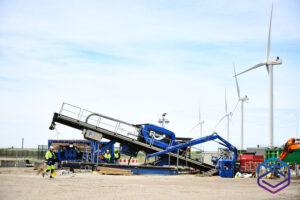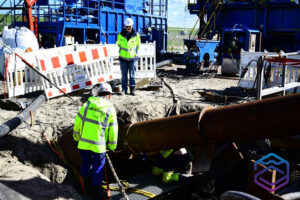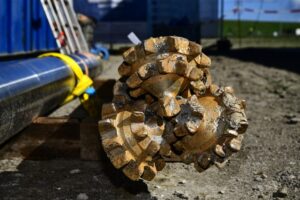13 April 2024
First drilling under seawall
After a period of preparation, construction of the infrastructure of CO2 transport and storage project Porthos has visibly started. Saturday 13 April saw the first drilling under the seawall on the Maasvlakte in Rotterdam.
The future CO2 storage project Porthos transports captured CO2 through the port of Rotterdam via a compressor station to a platform about 20 kilometres offshore. From the platform, the CO2 will be permanently stored in empty (depleted) gas fields three to four kilometres below the North Sea bed. The CO2 will arrive at the compressor station on the Maasvlakte from the port area. From there, a pipeline will then run to the platform at sea.
Casing tube
For the drilling under the seawall, a drill with a diameter of more than 300 mm was used. This drill dug under the sea wall to just below the seabed. The casing tube through which the CO2 pipeline will run is about 800 mm. The drill corridor will therefore be widened to a size of 1050 mm. The casing tube has a total length of 600 metres, for which 34 pipes were welded together last month. The casing tube will be pushed down the drill hole from landside. The CO2 pipeline itself will be routed through the casing during 2025.
Planning
In the near future, various contractors commissioned by Porthos will also work on the CO2 pipeline at other locations in the port of Rotterdam. This underground tubing system will transport captured CO2 from companies to the compressor station. The system will cross several waterways, train tracks and roads in the port area. The CO2 storage is scheduled to be operational in 2026.
Future CO2 storage projects
Porthos is a joint venture between EBN, Gasunie and the Port of Rotterdam Authority. Porthos plans to store about 2.5 Mtonnes of CO2 per year for 15 years, totalling about 37 Mtonnes which will then remain permanently stored under the North Sea. Thanks to Porthos, Rotterdam’s port industry will soon reduce its CO2 emissions by about 10%. The new onshore compressor station and transport system under construction will accommodate several future CO2 storage projects.




©PorthosCO2




